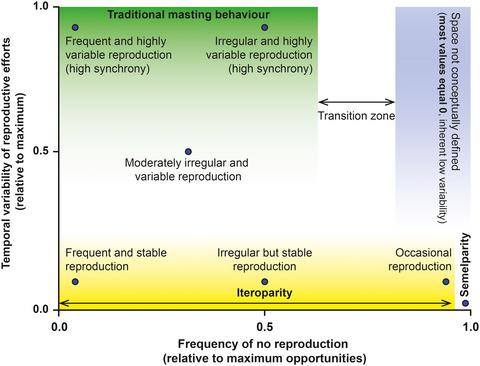当前位置:
X-MOL 学术
›
Ecol. Evol.
›
论文详情
Our official English website, www.x-mol.net, welcomes your
feedback! (Note: you will need to create a separate account there.)
Measuring temporal patterns in ecology: The case of mast seeding
Ecology and Evolution ( IF 2.3 ) Pub Date : 2021-03-11 , DOI: 10.1002/ece3.7291 Marcos Fernández-Martínez 1 , Josep Peñuelas 2, 3
中文翻译:

测量生态学中的时间模式:肥大播种的案例
更新日期:2021-04-04
Ecology and Evolution ( IF 2.3 ) Pub Date : 2021-03-11 , DOI: 10.1002/ece3.7291 Marcos Fernández-Martínez 1 , Josep Peñuelas 2, 3
Affiliation

|
- Properly assessing temporal patterns is a central issue in ecology in order to understand ecosystem processes and their mechanisms. Mast seeding has traditionally been described as a reproductive behavior consisting of highly variable and synchronized reproductive events. The most common metric used to measure temporal variability and thus infer masting behavior, the coefficient of variation (CV), however, has been repeatedly suggested to improperly estimate temporal variability. Biases of CV estimates are especially problematic for non‐normally distributed data and/or data sets with a high number of zeros.
- Some recent studies have already adopted new metrics to measure temporal variability, but most continue to use CV. This controversy has started a strong debate about what metrics to use.
- We here summarize the problems of CV when assessing temporal variability, particularly across data sets containing a large number of zeros, and highlight the benefits of using other metrics of temporal variability, such as proportional variability (PV) and consecutive disparity (D). We also suggest a new way to look at reproductive behavior, by separating temporal variability from frequency of reproduction, to allow better comparison of data sets with different characteristics.
- We suggest future studies to properly describe the temporal patterns in fully scientific and measurable terms that do not lead to confusion, such as variability and frequency of reproduction, using robust and fully comparable metrics.
中文翻译:

测量生态学中的时间模式:肥大播种的案例
正确评估时间模式是生态学的一个中心问题,以便了解生态系统过程及其机制。传统上,肥大播种被描述为一种由高度可变和同步的繁殖事件组成的繁殖行为。然而,变异系数 (CV) 是用于测量时间变异性并由此推断桅杆行为的最常用指标,但一再被认为不能正确估计时间变异性。对于非正态分布的数据和/或具有大量零的数据集,CV 估计的偏差尤其成问题。
最近的一些研究已经采用了新的指标来衡量时间变异性,但大多数研究继续使用 CV。这场争议引发了关于使用什么指标的激烈争论。
我们在这里总结了评估时间变异性时 CV 的问题,特别是在包含大量零的数据集上,并强调使用其他时间变异性指标的好处,例如比例变异性 (PV) 和连续视差 ( D )。我们还提出了一种观察繁殖行为的新方法,将时间变异性与繁殖频率分开,以便更好地比较具有不同特征的数据集。
我们建议未来的研究以完全科学和可测量的术语正确描述时间模式,不会导致混乱,例如繁殖的变异性和频率,使用稳健且完全可比较的指标。









































 京公网安备 11010802027423号
京公网安备 11010802027423号